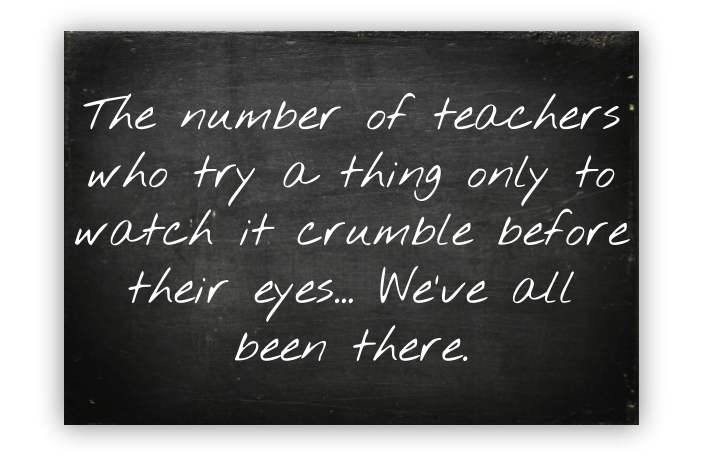
A bit of context
If you are an educator, then you have thought at least one of the following every year (month? week? day?!) of your career.
- I would LOVE to grade less… if my students would still do the work.
- I would LOVE to scrap the seating chart… if my students would be responsible.
- I would LOVE to allow phones and personal devices… if my students could be trusted.
- I would LOVE to open free collaboration and interaction… if my students could focus.
- I would LOVE to remove restrictions on bathroom, drink, and snack breaks… if my students would be reliable.
- I would LOVE to infuse constant cogenerative discussion… if my students would put forth honest effort. (Never heard of Cogen before? Listen to Lis Smith explain this incredible strategy!)
- …and so it goes…
This list is not exhaustive. You can add plenty more, I am sure. It does represent a healthy percentage of the concerns I had with my high school freshmen… and seniors.

The obvious problem here is that there are a great many best practices that are wonderful in theory but rather clunky in… well, practice. More precisely: the idea sounds great, but no way I can pull that off with my students!
Such rationale certainly is legitimate. The number of teachers who try a thing only to watch it crumble before their eyes… We’ve all been there. In fact, spend enough time there, and you get fairly versed at identifying whether that will happen with certain groups and certain strategies before you even try them. So naturally, you don’t try them.
The problem
The context now set, allow me to plainly state the message of this post. Most educators completely miss an essential distinction in this conversation: in all of the examples stated above (and likely most anything else that came to mind for you), the problem, as stated, has nothing to do with the strategy proposed. The problem, instead, is a motivation problem.
Some examples
Seating Chart
Consider the situation of flexible seating or simple choice in general. Great volumes of research suggest that such choices have consistent benefit. Most teachers will agree that the most significant obstacle is the likelihood of students making poor choices with the flexibility.
The problem, then, has nothing immediately to do with the chairs or the structure. It has to do with the students’ motivation to make responsible choices. If you knew without doubt that your students would be responsible with it, what would stop you from at least scrapping the seating chart?
Collaboration and Interaction
This one can be tough. Effective collaboration includes a combination of skills that few students naturally demonstrate with competence. But we all agree those skills are imperative and most definitely can be grown over time. Still, many cringe at the thought of allowing students to collaborate in fluid, unstructured, and flexible ways.
The problem, though, is not that students lack the skills or can’t be mentored and coached into competence. It is a problem of motivation to find the value in the experience and interact in a focused, academic manner. If you could trust that the vast majority of conversations and interactions in your classroom were focused and productive, wouldn’t you want your students talking constantly?
Grading and Evaluation
What is the purpose of grading? To evaluate understanding and provide evidence of growth and progress. Quintessentially, grading is NOT an accountability tool. That is, logically speaking, absurd. Let me put a grade on this so that you will be compelled to do it. This is going to be graded… so if you don’t do it, it will hurt your class grade! WHAT?!
Insert red-faced shame: while teaching high school ELA and history, those exact words flowed out of my mouth freely.
The hopeful trends in education right now include a great many grading reforms, some that involve, more or less, completely throwing out the practice of grading as we currently understand it. Now let me ask you for an honest opinion: if you could NEVER have to grade another thing, would you?
Once again, the problem is fundamentally one of motivation (there are ways to address the structural/systemic side). If you knew that every student would give reasonable and honest effort to every task you assigned… You get my point.
My conclusion
Stop letting motivation concerns obstruct practice decisions. How? Address motivation problems with motivation solutions and practice problems with practice solutions. In that order.
For many years, student motivation was a mysterious thing, to me, often falling in the category of the “art” of teaching (where content and instruction landed closer to the “science” of teaching). Recently, I have begun to realize that student motivation is not nearly as elusive as that. Sure, when talking about living breathing humans, there is a certain element of inconsistency and unpredictability, but not so much that certain practices can’t produce certain results very nearly all of the time.
Need proof? Consider this: caring. Predictably so, every student responds better to his/her teacher when believing that teacher cares. How about belonging? Can you think of someone who would not give a little more in a situation when feeling a sense of belonging (to the situation, group, context)?
If you have been following our work, then you are hearing some familiar words. I am referencing the work of Dave Stuart, Jr., author of These 6 Things, where you can read more about his Five Key Beliefs.
The reality is that educators too easily forego practices that we KNOW will improve teaching and learning because of problems that routinely point back to student motivation and engagement, and instead of working to address those problems so that we can then implement the practices, we say it’s “the nature of this group” or “the way things are” and miss the opportunity to do incredible things.
The best part is that EVERY teacher can start TODAY to make this change. Here’s what you need to do:
- Listen to Dave Stuart, Jr. explain the Five Key Beliefs and student motivation.
- Read his book, These 6 Things, to get the full perspective.
- Share what you’re discovering with your peers.
Start diagnosing problems accurately and treating them accordingly. If it’s motivation, culture, etc., do something about it!


